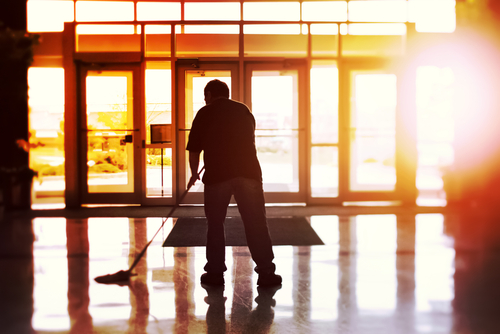Last year was an exceedingly difficult time for many administrators who were focused on keeping their facilities healthy. It was also a difficult period for the professional cleaning industry, specifically the people performing cleaning tasks.
Why it was such a difficult year was because so much about the pandemic was unknown.

Some guidance issued by reputable organizations at the start of the pandemic regarding best practices for cleaning were later rescinded or found to be incorrect. Unfortunately, many administrators may still be uncertain how they should maintain their facilities to ensure they are healthy. Some of the steps they took last year—including using large amounts of disinfectants—are now viewed as unnecessary, costly, and unhealthy to the user as well as those working in the facility.
So, what should administrators do to address this situation? How can they make sure they are using the right cleaning products and procedures to protect their staff and keep their facilities open?
Conducting what some are now referring to as a “post-COVID site analysis” should help.
A post-COVID site analysis takes a close look at which cleaning products and processes are now being used to maintain the facility, evaluate if those are the most effective—and cost effective—and then suggest alternatives that might be more suitable. But before we begin, there are two things we must remember:
- No two facilities are alike. What works in one location may not work in another for a variety of reasons.
- Further, it is crucial that administrators pay close attention to CDC guidelines as they pertain to COVID. While they have been relatively stable for a while now, recommendations can change at any time.
Conducting a Post-COVID Site Analysis

Our discussion will not examine such things as whether social distancing is being practiced, shields (wall divisions) are installed, or masks are being worn. Instead, the analysis will focus on surfaces—walls, floors, counters, restrooms, common areas, etc.—and how they are being maintained. There is at least one free online dashboard system available that can help administrators accomplish this. However, because of the seriousness of the pandemic, it is best to use a dashboard and work with an astute distributor of janitorial products. The combination helps eliminate any trial-and-error purchasing.
Here are some of the most important steps in a post-COVID site analysis:
- List all common work areas, meeting rooms, break rooms, cafeterias, and locker rooms, and note how often they are being cleaned and what cleaning solutions (cleaner, sanitizers, and/or disinfectants) are being used.
- Do the same with all restrooms.
- Determine how often floors are being cleaned and again what solutions are being used; note if the floors are being mopped or if automated systems are being used such as automatic scrubbers. Automated systems are less likely to spread contaminants.
- Note all high-touch areas throughout the property. Include such things as coffee pots, vending machines, water fountains, etc. Here is where an outside person such as a distributor can be helpful. Often their fresh eyes see things you may not.
- Determine how often surfaces are being tested for pathogens. In some facilities, as many as 10 different surfaces are tested using ATP monitors every day, including multiple areas on those surfaces.
Now that we have identified five key steps in a site analysis, let’s discuss each one in greater detail.
Common areas: Heavily populated common areas are where germs, bacteria, and other contaminants typically collect. These surfaces must be cleaned using an all-purpose cleaner and then disinfected. This is a two-step process—clean first, then disinfect. Make sure the disinfectant used has been proven effective against COVID by the U.S. Environmental Protection Agency (EPA).
Restrooms: At this time, we would follow the same steps in restrooms. Normally, however, restrooms only need to be sanitized. In professional cleaning, sanitized means that the number of germs on a surface has been reduced to a safe level based on current public health standards. However, right now, many public health standards are recommending disinfection, which is the total removal of germs on a surface.* Follow their recommendations at this time.
Floors: Many facilities are using disinfectants on their floors. It’s true that the pathogen that causes COVID has been found on floors. However, it is now believed that the pathogen has a short lifespan. Because of this, floors in most facilities should only need to be cleaned regularly with an effective floor cleaner. Using a disinfectant or even a sanitizer may not be necessary, which helps protect the health of the cleaning worker and the environment.
High-touch surfaces. We do need to clean and disinfect high-touch areas. Remember, this is a two-step process. However, cleaners are available for high-touch areas that both clean and disinfect in one step; an astute distributor can suggest such products.
ATP. ATP, which stands for adenosine triphosphate, replaces the Petri dish. Using an ATP monitor, surfaces can be swabbed with test results determined in as little as 15 seconds. A high ATP reading serves as a red flag that contaminants may be present on a surface.
We have just covered the basics here of a post-COVID site analysis. There is one thing more we recommend, and that is making sure staffers are aware that the analysis is being conducted. Often these people know a facility better than administrators when it comes to cleaning and health. Furthermore, they will appreciate that your facility is taking these added steps to protect their health.
Gretchen Friedrich is with AFFLINK, a global leader in supply chain optimization, packaging, and marketers of advanced cleaning products and technologies that minimize the spread of infection.
*All disinfectants will have kill claims. If used properly, the disinfectant should kill all pathogens on a surface based on the kill claims listed on the label.
